#Syunik Province
Explore tagged Tumblr posts
Text
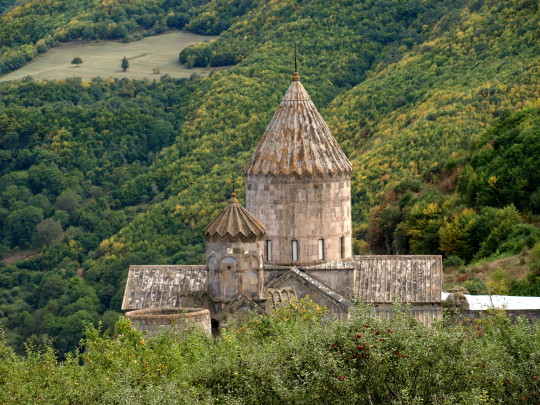
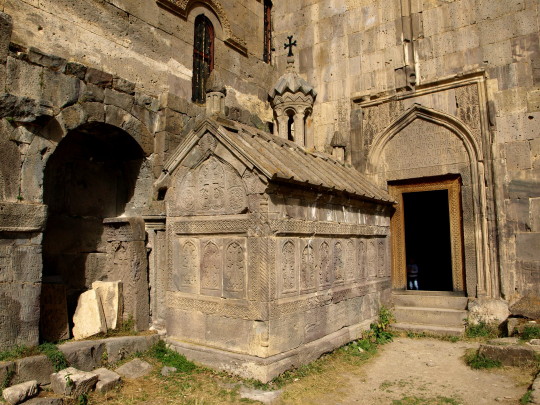
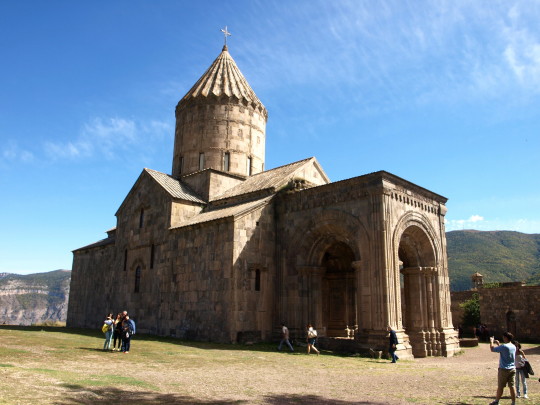
Tatev Monastery (2) (3) by Hugi Ólafsson
Via Flickr:
The Tatev Monastery in southern Armenia dates from the 9th century. The monastic ensemble stands on the edge of a deep gorge of the Vorotan River. In the 14th and 15th centuries Tatev Monastery hosted one of the most important Armenian medieval universities, the University of Tatev, which contributed to the advancement of science, religion and philosophy, reproduction of books and development of miniature painting. Scholars of the Tatev University contributed to the preservation of Armenian culture and creed during one of its most turbulent periods in its history. The buildings of the ensemble were severely damaged in a 1931 earthquake and have only been partially restored.
331 notes
·
View notes
Text
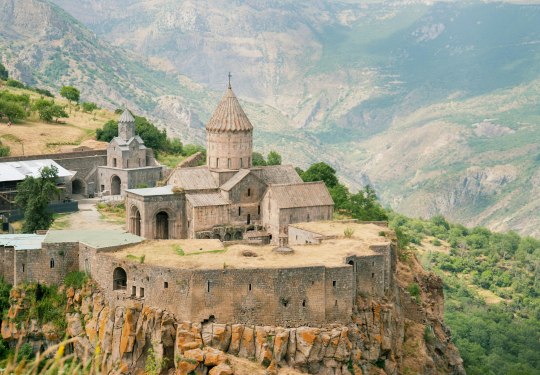
Tatev, Syunik Province, Armenia
Evgeny Matveev
2 notes
·
View notes
Note
your name is so pretty!! is there an origin/meaning??
Thank you!
The name "Tatev" /Տաթև/ is derived from two Armenian words: "ta" (տա), which means "give," and "tev" (թև), which means "wing." Together, "Tatev" can be interpreted as "give wings".

The name has its origins in the name of a famous medieval monastery in Armenia, the Tatev Monastery, located in the Syunik Province. Close to the monastery is the "Wings of Tatev," the world's longest reversible cableway, which stretches over 6 kilometers.
According to a popular legend, the name "Tatev" is connected to the story of the construction of the Tatev Monastery. It is said that when the master architect completed the monastery, he prayed to God to grant him wings so he could fly and witness his creation from above. He said "ta tev," which translates to "Give me wings". Miraculously, he was gifted wings and flew over the monastery.
In another context, "Tatev" symbolizes the concept of spiritual flight and enlightenment. The monastery was a major center of learning and scholarship in medieval Armenia. So, the name reflects the monastery's role in "uplifting" the minds and spirits of those who studied, lived and worshipped there.
103 notes
·
View notes
Photo
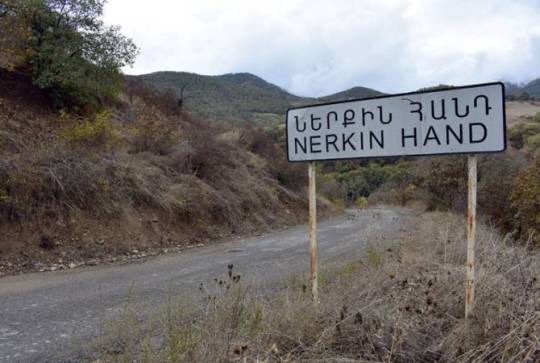
New Post has been published on https://massispost.com/2024/02/four-armenian-soldiers-killed-and-another-wounded-in-azerbaijani-shooting/
Four Armenian Soldiers Killed and Another Wounded in Azerbaijani Shooting

YEREVAN — Four Armenian soldiers were killed and another wounded when their positions on Armenia’s border with Azerbaijan came under cross-border fire early on Tuesday. Armenia’s Defense Ministry said its outposts around the border village of Nerkin Hand in southeastern Syunik province were targeted for four hours. The gunfire stopped at 9:30 a.m., it said in a statement. The head of the village administration, Khachatur Baghdasaryan, told RFE/RL’s Armenian Service that he heard intense gunshots at around the same time. Azerbaijan confirmed that its troops deployed in the area opened fire early in the morning. Its State Border Service claimed…
21 notes
·
View notes
Text
aliyev just got reelected and here he is not even pretending anymore about what he wants Armenia to do: roll the fuck over and die at the hands of azerbaijan after azerbaijani forces attacked Gegharkunik province and the Syunik province.
ugh.
9 notes
·
View notes
Text
"I Dressed Like a Crazy Pharoah for You Man!" (Azerbaijan Edition)
Azerbaijan is holding a Potemkin presidential election tomorrow. But what makes this one especially outstanding is that not only did the authoritarian incumbent put a bunch of fake "opposition" parties on the ballot, he's also having them release deliberately idiotic policy proposals so he looks better by comparison (h/t). The "opposition" candidates have brought some color to the election campaign by mooting a number of unlikely policy proposals: renaming the country the North Azerbaijan Republic, a nod to nationalist discourse that dreams of a greater Azerbaijan, including the ethnic Azerbaijani minority regions of Iran; formally claiming Armenia's Syunik Province as Azerbaijani; or sending Azerbaijani troops to support Russian forces in Syria. "They want to talk about all these stupid ideas in order to show that Aliyev is better [and] that these are the only alternatives," Open Azerbaijan's [Zohrab] Ismayil said. Wasn't this a plotline on Community? The presidential "debate" was equally farcical: At a debate held before Azerbaijan's February 7 presidential election, the viewer could be forgiven for not being sure who was supporting the incumbent and who represented the opposition. "President Ilham Aliyev has kept his word and fulfilled every promise he has made," said one candidate, Fuad Aliyev (no relation to the president), at the January 15 public television debate. Another candidate, Zahid Oruc, argued that great Azerbaijani statesmen throughout history would all have voted for Aliyev. The president himself did not appear at the debate but sent an emissary, Tahir Budagov, to absorb some of the flattery. "Dear Mr. Tahir, do you know the strengths of the candidate you represent?" Razi Nurullayev, the head of the National Front Party, asked Budagov. "For years, our party has stated that we will liberate Karabakh and restore the integrity and sovereignty of Azerbaijan, but your candidate has done it," Nurullayev said, referring to Azerbaijan's recapture of the ethnic Armenian-dominated region of Nagorno-Karabakh in September 2023. One almost has to respect the commitment to bootlicking. Almost. via The Debate Link https://ift.tt/zuXplBM
6 notes
·
View notes
Photo

H45 between Goris and Syunik, Syunik Province, Armenia by Len Gao
2 notes
·
View notes
Text
The beehives were in no man’s land. After the border clash near his village in April, Geram drove down to the fields where his family has been farming for decades and kept a small apiary.
But when he got near, he heard gunshots. The Azerbaijanis were firing at him from their new positions on the surrounding hilltops. He ran back to his car and never returned.
Another local, Samvel Hyusunts, lost nearly 70 hectares (173 acres) where his family had been farming wheat for decades. “They take what they can have,” he says, standing in a dusty suit and flat cap on the roadside where thousands of refugees have passed from Karabakh into Armenia. “The village is suffering.”
It would hardly be of note if this was in Nagorno-Karabakh, where hundreds have been killed and tens of thousands have fled as Azerbaijan closes in on “reintegrating” its territories in what many Armenians say is a campaign of ethnic cleansing.
But Tegh is in Armenia proper, and the April incident before the war points to how a series of border clashes and encroachments could presage the next great crisis: a revanchist Azerbaijan emboldened by its victory in Nagorno-Karabakh, now eyeing a land corridor to Turkey or even annexing entire regions of what hawks in Baku have begun to call “western Azerbaijan.” In fact, that land is Armenia.
“Initially, it was all about Karabakh and improving their bargaining position and threatening the Armenians’ territorial integrity to deter their support for Karabakh Armenians,” said Stefan Meister, head of the Centre for Order and Governance in Eastern Europe, Russia, and Central Asia at the Berlin-based German Council on Foreign Relations.
“Now, since they have Karabakh under control, they don’t need any agreement with the Armenian government. They might just move forward and say: ‘OK, we have some territory and we take some more. Or just take the whole Syunik region.”
He added: “It’s part of this maximalist approach: you’re hungry and you never stop eating if no one puts a red line,” and said that he had urged western governments to consider sanctions on Baku.
Geram has little doubt another war is coming. He points to the hilltops nearby: “You can see the Azerbaijanis now have positions there, and there and there. Whoever is stronger makes the rules.
“I fear it won’t be us,” he says, standing outside the small corner shop on the main road through Tegh where he works most days. He brings out a pair of binoculars to show the land where his family used to farm.
After losing a war in 2020, Armenian prime minister Nikol Pashinyan signed a ceasefire agreement with Azerbaijan brokered by Russia that grants a land corridor through Armenia to Nakhchivan, an Azerbaijani exclave, and on to Turkey, Azerbaijan’s closest ally. The corridor, which was to run along a railway through southern Armenia, was to be policed by the FSB, Russia’s main border guard service.
But the Azerbaijani parliament has also held recent hearings on western Azerbaijan, an irredentist term that the country’s president, Ilham Aliyev, has also started to use in public and which in particular refers to the Syunik province, where Tegh is located.
Every local understands they are in harm’s way. Samvel, a shepherd, takes his long stick and draws a map in a muddy path – here is Azerbaijan and here is Turkey, he says, and only Armenia’s Syunik region, where we are, sits between them.
Samvel once had a flock of 500 sheep, he says, but lost his grazing lands near the border after the 2020 war and was forced to sell off all but 30. He lost an eye in the fighting in the 1990s, he said, when a grenade sent shrapnel through the left side of his face. He says that Armenia is being overpowered by Azerbaijan and a coterie of international allies, among which he includes Russia. “Soon there are going to be no Armenians left,” he adds.
It is not guaranteed that the end of the Nagorno-Karabakh government will lead to further fighting between Azerbaijan and Armenia.
As Benyamin Poghosyan, senior fellow on foreign policy at the Applied Policy Research Institute of Armenia noted, one line of thought is that the flight of the Karabakh population to Armenia could, somewhat counterintuitively, remove a stumbling block to the two countries signing a peace treaty.
Armenia’s own parliament speaker has said the sides are very close to having a “historic opportunity to sign a peace agreement”.
But, Poghosyan said, it is more likely that Azerbaijan would be emboldened by the Karabakh victory to demand further concessions, including the transit route to Nakhchiven.
“The destruction of Karabakh will allow Azerbaijan to focus all its forces ��� military, diplomatic, political – in Armenia’s direction,” he said.
He added that in the long-term, Azerbaijan may set itself the goal of occupying part of the Syunik or Vayots Dzor regions, but that it would probably take more incremental steps in the short term to prevent an international backlash.
“They can penetrate in one or two directions … and then offer Armenia that if you would like Azerbaijan troops to return to the prewar positions, you should accept the opening of routes to connect Azerbaijan with Nakhchivan,” Poghosyan said.
Those routes could include an attack at Jermuk, a mountain town in the northern Vayots Dzor region, where Azerbaijani troops have been already taken positions in the heights overlooking the settlement, or at Kapan, the capital of the Syunik region, he said.
From Tegh, looking out over the fields that lead to Karabakh, Samvel the shepherd says he hopes to see peace but expects there to be war.
“Before it was Karabakh,” he says, “But now all of Karabakh has come here. I fear they might not be far behind.”
3 notes
·
View notes
Text
The top 6 places to visit in Armenia for a beautiful vacation.
Armenia, a small yet incredibly diverse country in the South Caucasus region, is a hidden gem waiting to be explored. Known for its rich history, stunning landscapes, and warm hospitality, Armenia offers a unique blend of ancient culture and natural beauty. Whether you are a history buff, a nature lover, or simply seeking a peaceful getaway, Armenia has something special to offer. From the bustling streets of its capital, Yerevan, with its vibrant atmosphere and historic landmarks, to the serene shores of Lake Sevan, known as the "Pearl of Armenian Nature," there are countless places to discover. The lush forests and scenic trails of Dilijan National Park, often referred to as the "Armenian Switzerland," provide a perfect escape into nature. Ancient monasteries like Tatev and Geghard, perched on cliffs and carved out of mountains, showcase the country’s deep spiritual roots and architectural brilliance. Armenia's top destinations promise unforgettable experiences and breathtaking views. Whether you’re marvelling at the majestic Mount Ararat from Khor Virap or exploring the ancient ruins of Garni Temple, each site offers a glimpse into the country's rich cultural heritage. Embark on a journey to Armenia and uncover the beauty and charm of this remarkable land.

Here are some places to visit in Armenia for a beautiful vacation.
1. Yerevan:
Armenia's capital, Yerevan, is a bustling city full of culture and history. Known as the "Pink City" because of its structures made of pink volcanic stone, Yerevan provides a blend of modern and traditional. Explore Republic Square, which features dancing fountains and stunning architecture, as well as the Cascade Complex, which provides expansive views of Mount Ararat and the city. The city is also home to a number of institutions that highlight the rich artistic and historical legacy of the nation, such as the National Gallery of Armenia and the Armenian Genocide Museum.
2. Sevan Lake:
The largest lake in Armenia, Lake Sevan, is sometimes called the "Pearl of Armenian Nature." Nestled amidst breathtaking scenery, this high-altitude lake in the Gegharkunik Province provides a tranquil haven. In addition to exploring the old Sevanavank Monastery, which is situated on a peninsula with stunning views of the lake, visitors can unwind on the beaches and swim in the crystal-clear waters. For those who appreciate the outdoors and want some peace and quiet, Lake Sevan is the ideal location.
3. The National Park of Dilijan:
Often referred to as the "Armenian Switzerland," Dilijan National Park is renowned for its verdant forests, placid lakes, and breathtaking scenery. The park, which is in the Tavush Province, is a hiking and outdoor enthusiasts' paradise. Discover the many trails in the park, the quaint village of Dilijan with its historic architecture, and the historic monasteries like Haghartsin and Goshavank tucked away in the hills covered with forest. A tranquil haven and an opportunity to get in touch with nature may be found in Dilijan National Park.
4. The Tatev Monastery:
Situated in the Syunik Province, Tatev Monastery is a historical and architectural marvel. The monastery provides breathtaking views of the surroundings from its perch on the brink of a deep canyon. The structure, which was built in the ninth century, is a significant hub for Armenian religion and culture. The world's longest reversible aerial tramway, Wings of Tatev, offers stunning vistas and an exciting journey that visitors can take to reach the monastery. For history enthusiasts as well as those looking for spiritual and picturesque experiences, Tatev Monastery is a must-visit.
5. Geghard Monastery and Garni Temple:
Two of Armenia's most famous historical sites are the Garni Temple and the Geghard Monastery. The Garni Temple is a well-preserved pagan temple from the first century AD that is situated in Kotayk Province. It is Armenia's only surviving example of a colonnaded Greco-Roman structure. The nearby Geghard Monastery is surrounded by cliffs and partially carved out of a mountain; it is recognized as a UNESCO World Heritage Site. The complex of monasteries comprises multiple churches and tombs that exhibit remarkable medieval Armenian architectural design and artisanship. An intriguing look into Armenia's rich architectural legacy and ancient history can be had by visiting these locations.
6. Khor Virap :
Khor Virap, one of Armenia's most well-known pilgrimage destinations, is situated close to the Turkish border. The monastery is perched atop a hill with Mount Ararat, Armenia's national symbol, providing a breathtaking backdrop. Because Saint Gregory the Illuminator was imprisoned there before converting King Tiridates III and establishing Christianity as the official religion of Armenia, Khor Virap holds historical significance. In addition to soaking in the breath-taking vistas of Mount Ararat, visitors can explore the monastery and discover its history. Khor Virap is a beautiful and mystical place that is not to be missed.
Conclusion
Exploring the top places to visit in Armenia offers an unforgettable experience filled with history, culture, and natural beauty. From the vibrant capital city of Yerevan to the serene shores of Lake Sevan, Armenia provides diverse attractions that cater to all types of travelers. The lush landscapes of Dilijan National Park and the ancient monasteries like Tatev and Geghard reveal the rich heritage and breathtaking scenery that define this beautiful country. When planning your trip, consider Armenian tour packages that include visits to these must-see destinations. These packages often provide guided tours, comfortable accommodations, and convenient transportation, ensuring a hassle-free and enriching experience.
Whether you want to explore the ancient history at Khor Virap or enjoy the tranquil beauty of the Armenian countryside, Armenia holiday packages can help you make the most of your vacation. Armenia's unique blend of cultural landmarks, natural wonders, and warm hospitality makes it an ideal destination for a memorable holiday. By choosing a comprehensive Armenia tour package, you can fully immerse yourself in the charm and beauty of this remarkable country. Embark on an Armenian adventure and discover why it is quickly becoming a favourite destination for travelers seeking both relaxation and exploration.
0 notes
Text
Experiencing Armenia: A Comprehensive Guide to Top Destinations and Visa Requirements
Armenia, nestled in the South Caucasus region, offers a captivating blend of ancient history, stunning landscapes, and vibrant culture. From its UNESCO World Heritage sites to its picturesque countryside, there's an abundance of places to explore. In this guide, we'll unveil the top destinations to visit in Armenia and provide essential information on visa requirements for travelers.
Yerevan: Begin your Armenian journey in its capital city, Yerevan, known as the "Pink City" for its distinctive rose-colored buildings. Explore the bustling streets of the city center, where modern cafes and restaurants blend with Soviet-era architecture. Don't miss the iconic Cascade Complex, Matenadaran Manuscript Museum, and the poignant Armenian Genocide Memorial.
Garni Temple: Journey back in time to the ancient Hellenistic era with a visit to Garni Temple, the only surviving pagan temple in Armenia. Perched majestically on a cliff overlooking the Azat River Gorge, this architectural marvel is a testament to Armenia's rich cultural heritage. Marvel at its Greco-Roman design and panoramic views of the surrounding landscape. Also Read: Georgia visa
Geghard Monastery: Discover the spiritual oasis of Geghard Monastery, a UNESCO World Heritage site nestled within the picturesque Azat River Valley. Carved into the rock formations, this medieval monastery complex is renowned for its unique architecture and sacred relics. Explore the intricately adorned chambers and chapels, and immerse yourself in the tranquil ambiance of this ancient sanctuary.
Lake Sevan: Escape to the serene shores of Lake Sevan, the "Jewel of Armenia," located amidst the stunning landscapes of the Armenian Highlands. Admire the azure waters of the lake, framed by lush forests and snow-capped mountains. Explore the historic Sevanavank Monastery perched on a peninsula, and indulge in local delicacies such as fresh fish from the lake. Also Read: Philippines visa
Tatev Monastery: Embark on a scenic journey to Tatev Monastery, perched atop a rugged cliff in the Syunik Province. Accessible via the Wings of Tatev aerial tramway, this medieval monastery complex offers panoramic views of the Vorotan River Gorge. Explore its ancient churches, chapels, and fortifications, and marvel at the intricate stone carvings adorning its walls.
Noravank Monastery: Unveil the architectural splendor of Noravank Monastery, nestled amidst the red-hued cliffs of the Amaghu Valley. Dating back to the 12th century, this historic monastery complex is renowned for its ornate stone carvings and stunning backdrop. Visit the iconic Surb Astvatsatsin Church and the intricate Noravank Khachkar, a UNESCO Intangible Cultural Heritage. Also Read: Russia visa
Dilijan National Park: Immerse yourself in the pristine wilderness of Dilijan National Park, often referred to as "Armenia's Switzerland." Explore lush forests, crystal-clear lakes, and meandering hiking trails amidst the breathtaking landscapes of the Lesser Caucasus Mountains. Discover the historic monasteries of Haghartsin and Goshavank, nestled amidst the verdant surroundings. Also Read: Cameroon visa
Khor Virap Monastery: Unravel the spiritual significance of Khor Virap Monastery, located at the foot of Mount Ararat near the Turkish border. This revered pilgrimage site offers panoramic views of the iconic Mount Ararat, believed to be the resting place of Noah's Ark. Explore the underground chambers where Saint Gregory the Illuminator was imprisoned, and soak in the tranquil ambiance of this sacred sanctuary. Also Read: India visa
Jermuk: Relax and rejuvenate in the scenic spa town of Jermuk, renowned for its mineral-rich hot springs and therapeutic waters. Nestled amidst the lush forests of the Vayots Dzor Province, Jermuk offers a tranquil retreat amidst the natural beauty of the Armenian Highlands. Indulge in spa treatments, take a leisurely stroll along the Jermuk Waterfall, and sample local delicacies such as Jermuk mineral water and honey. Also Read: Hong Kong visa
Gyumri: Experience the vibrant culture and rich heritage of Armenia's second-largest city, Gyumri. Explore its historic streets lined with colorful 19th-century buildings, and visit landmarks such as the Black Fortress and the Sev Berd Fortress. Discover the city's artistic soul at the Gyumri Museum of National Architecture and Urban Life, and immerse yourself in the lively atmosphere of the Kumayri Historic District.
Guide to Armenia Visa Requirements:
Traveling to Armenia is relatively straightforward for many nationalities, as it offers visa-free access or visa-on-arrival for citizens of numerous countries. However, it's essential to check the visa requirements specific to your nationality before planning your trip. Here's a guide to Armenia visa requirements:
Visa-Free Countries: Citizens of several countries, including EU member states, the United States, Canada, Australia, and many others, can enter Armenia visa-free for short stays ranging from 90 to 180 days. Travelers should check the official website of the Ministry of Foreign Affairs of Armenia for the latest information on visa-free access.
Visa-On-Arrival: For citizens of countries not eligible for visa-free access, Armenia offers a visa-on-arrival option at Yerevan Zvartnots International Airport and certain land border crossings. Travelers can obtain a visa-on-arrival for a fee and valid for stays of up to 120 days. However, it's advisable to check the specific requirements and conditions before traveling.
E-Visa: Armenia also offers an electronic visa (e-visa) application system for citizens of select countries. Travelers can apply for an e-visa online through the official website of the Ministry of Foreign Affairs of Armenia. E-visas are typically issued within a few business days and are valid for single-entry visits for tourism or business purposes.
Visa Extensions: For travelers planning to stay in Armenia for longer than the permitted visa-free or visa-on-arrival period, it's possible to extend their stay by applying for a visa extension at the Passport and Visa Department of the Police of the Republic of Armenia. Extensions are subject to approval and must be requested before the initial visa expires.
Important Documents: When applying for a visa or entering Armenia, travelers should ensure they have a valid passport with a minimum validity of six months beyond the intended stay, as well as any required supporting documents such as proof of accommodation, return flight tickets, and travel insurance.
Conclusion: Armenia's rich history, breathtaking landscapes, and warm hospitality make it a captivating destination for travelers seeking an authentic cultural experience. From the ancient monasteries of Geghard and Tatev to the vibrant streets of Yerevan and Gyumri, there's no shortage of places to explore in this enchanting country. Whether you're drawn to its UNESCO World Heritage sites, picturesque natural scenery, or vibrant urban culture, Armenia offers a wealth of experiences waiting to be discovered. With its relatively straightforward visa requirements and welcoming atmosphere, Armenia invites travelers from around the world to embark on a journey of discovery and exploration.
1 note
·
View note
Text
Tatev monastery is a 9th century Armenian monastery located in the Tatev village in Syunik Province in southern Armenia.
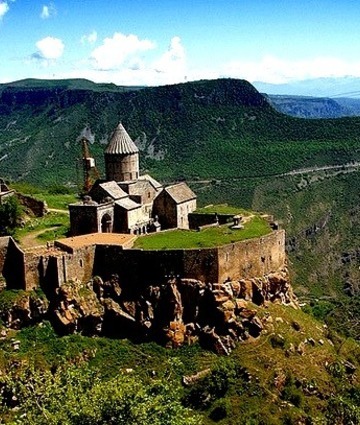
0 notes
Text

Tatev Monastery, Tatev, Tatev Municipality, Syunik Province, Armenia
Rafael Ishkhanyan
1 note
·
View note
Photo

New Post has been published on https://massispost.com/2024/09/armenia-thanks-iran-for-opposing-land-corridor-through-its-territory/
Armenia Thanks Iran for Opposing Land Corridor Through It’s Territory

YEREVAN — Senior Armenian officials have thanked Iran for reaffirming its strong opposition to land corridors passing through Armenia in response to Russia’s latest push for the opening of such transport links between Azerbaijan and its Nakhichevan exclave. Tehran stepped up at the weekend its criticism of Moscow’s position expressed by Russian Foreign Minister Sergei Lavrov during President Vladimir Putin’s August 18-19 visit to Baku. Lavrov accused Armenia of “sabotaging” a Russian-brokered agreement to build a highway and railway connecting Nakhichevan to the rest of Azerbaijan via Syunik, the only Armenian province bordering Iran. The accusation prompted serious concern from…
0 notes
Text
Tatev monastery is a 9th century Armenian monastery located in the Tatev village in Syunik Province in southern Armenia.

0 notes
Text
Tatev monastery is a 9th century Armenian monastery located in the Tatev village in Syunik Province in southern Armenia.

0 notes
